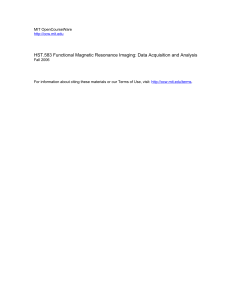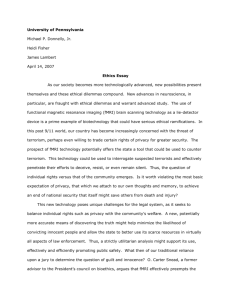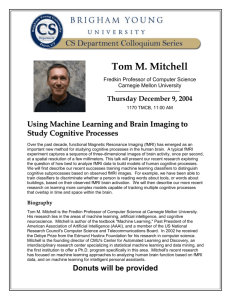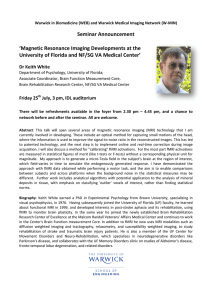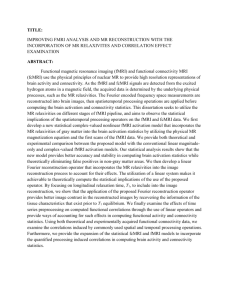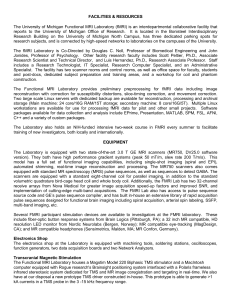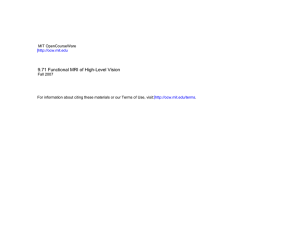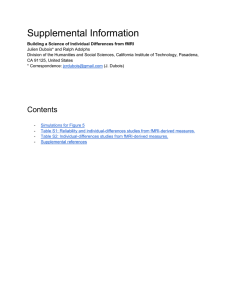NeuroVault and the vision for data sharing in neuroimaging Chris Gorgolewski
advertisement
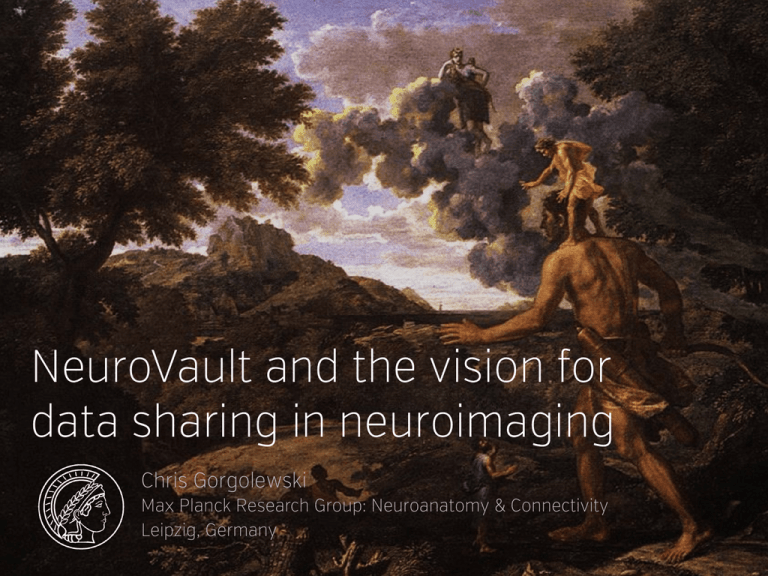
NeuroVault and the vision for data sharing in neuroimaging Chris Gorgolewski Max Planck Research Group: Neuroanatomy & Connectivity Leipzig, Germany Data sharing? Data sharing? • Ok, ok so we should share data. • We all know it’s good. • But almost no one does it. – You have to prepare data – You risk that your mistakes will be found! Part I: Large scale data sharing is a fact Part II: Data sharing does not have to be expensive Part III: Making data sharing count Part IV: Implications of data sharing The data out there is calling you… PART I: LARGE SCALE DATA SHARING IS A FACT NKI Enhanced • 329 subjects (will reach 1000) – Representative sample: young and old, some with mental health history • 1 hour worth of MRI (3T) scanning: – MPRAGE (TR = 1900; voxel size = 1mm isotropic) – 3x resting state scans (645msec, 1400msec, and 2500msec) – Diffusion Tensor Imaging (137 direction; voxel size = 2mm isotropic) – Visual Checkboard and Breath Holding manipulations fcon_1000.projects.nitrc.org/indi/ enhanced/ Human Connectome Project • ~232 subjects (will reach 1200) – Young and healthy (22-35yrs) – 200 twins! • 1 hour worth of MRI scanning: – Resting-state fMRI (R-fMRI) – Task-evoked fMRI (T-fMRI) • • • • • • • Working Memory Gambling Motor Language Social Cognition Relational Processing Emotion Processing – Diffusion MRI (dMRI) Human Connectome Project • Rich phenotypical data – Cognition, personality, substance abuse etc. • Genotyping! • Methodological developments (not yet available) – Fine tuned sequences – New preprocessing techniques • Ready to use preprocessed data humanconnectome.org Test-retest datasets • NKI multiband Test-retest • Classification learning and stop-signal (1 year test-retest) • A test-retest fMRI dataset for motor, language and spatial attention functions FCP/INDI Usage Survey FCP/INDI Data Usage Description Master's thesis research Doctoral dissertation research Teaching resource (projects or examples) Pilot data for grant applications Research intended for publication Independent study (e.g., teach self about analysis) 11.94% 38.81% 13.43% 16.42% 76.12% 37.31% FCP/INDI Users; 10% respondent rate Survey Courtesy of Stan Colcombe & Cameron Craddock Sharing little things… PART II: DATA SHARING DOES NOT HAVE TO BE EXPENSIVE Just coordinates? • Databases such as Neurosynth or BrainMap rely on peak coordinates reported in papers (only strong effects) Are we throwing money away? Baby steps • Everything is a question of cost and benefit – If we keep the cost low even small benefit (or just conviction that data sharing is GOOD) will suffice NeuroVault.org simple data sharing • Minimize the cost! • We just want your statistical maps with minimum description (DOI) – If you want you can put more metadata, but you don’t have to • We streamline login process (Google, Facebook) Benefits? • In return authors get interactive web based visualization of their statistical maps – Something they can embed on their lab website • We are keeping both cost and benefit low… – …but we also plan to work with journal editors to popularize the idea Live demo Using NeuroVault… • • • • • Improves collaboration Makes your paper more attractive Shows you care about transparency Takes only five minutes Gives you warm and fuzzy feeling that you helped future meta-analyses NeuroVault for developers • RESTful API (field tested by Neurosynth) • Source code available on GitHub NeuroVault.org Credit where credit’s due PART III: MAKING DATASHARING COUNT Motivation • Share your stat maps! vs. institutions scientists Quality control • Share your stat maps! Complex datasets require elaborate descriptions Solution – data papers • Authors get recognizable credit for their work. – Even smaller contributors such as RAs can be included. • Acquisition methods are described in detail. • Quality of metadata is being controlled by peer review. Gorgolewski, Milham, and Margulies, 2013 Where to publish data papers? • Neuroinformatics (Springer) • Frontiers in Human Brain Methods (Frontiers Media) • GigaScience (BGI, BioMed Central) • Scientific Data (Nature Publising Group, coming soon) Where to publish data papers? • Neuroinformatics (Springer) • Frontiers in Human Brain Methods (Nature Publishing Group) • GigaScience (BGI, BioMed Central) • Scientific Data (Nature Publising Group, coming soon) PART IV: IMPLICATIONS OF DATASHARING Sample sizes will grow By combining multiple shared datasets or using one of the big datasharing initiatives we will gain access to bigger sample Bigger samples • Better parameter estimates • Lower ratio of false positives (and false negatives) • Lower risk of inflated effect sizes • Higher power: better sensitivity to small effects Is more power bad? • In classical hypothesis testing the null hypothesis usually states no difference • However nothing in nature is exactly the same • In most cases we just don’t have enough power to see it • Some differences are more important than others Ridgway, Gerard (2013): Illustrative effect sizes for sex differences. figshare. http://dx.doi.org/10.6084/m9.figshare.866802 Is more power bad? • No – an “overpowered study” is an oxymoron • But we will need to revise our methods • Incorporate our assumption of what is a trivial effect size in our analyses – Either through Bayesian framework or different null hypotheses • Start looking at effect and confidence interval maps instead of just thresholded p-maps Vibration effect • While analyzing an MRI dataset we face a plethora of choices • Some alternatives have no clear bad or good options • The vibration effect is the ratio of effect size of the highest and lowest effects across all processing options Ioannidis, J. P. a. (2008). Why most discovered true associations are inflated. Vibration effect • Carp J (2012) On the plurality of (methodological) worlds: estimating the analytic flexibility of fMRI experiments. Front. Neurosci. 6:149. doi: 10.3389/ fnins.2012.00149 Vibration effect • We will finally see how much (or little) our analyses replicate over different datasets and methods Take home message(s) I. Take advantage of shared data II. Share your statistical maps at NeuroVault.org III. Share your data and publish a data paper IV. Expect changes in the way we analyze our data Acknowledgements (my personal giants) Pierre-Louie Bazin Haakon Engen Satrajit Ghosh Russell A. Poldrack Jean-Baptiste Poline Yannick Schwarz Tal Yarkoni Michael Milham Daniel Margulies Benjamin Baird Jonathan Smallwood Yannick Schwarz Florence J.M. Ruby Melaina Vinski Camille Maumet Dan Lurie Sebastian Urchs Judy A. Kipping R. Cameron Craddock MPI CBS Resting state group THANK YOU! “I swear I’ve heard it before” • In the past there were many attempts to propagate data sharing – For example fMRI DC: • technical issues • …and the amount of time it took to prepare data for submission (a week, a very frustrating week) • fMRI DC was however very ambitious for its time: – They wanted to collect raw data and all metadata required to reproduce the analysis Van Horn & Gazzaniga (2013). Why share data? Lessons learned from the fMRIDC. NeuroImage
